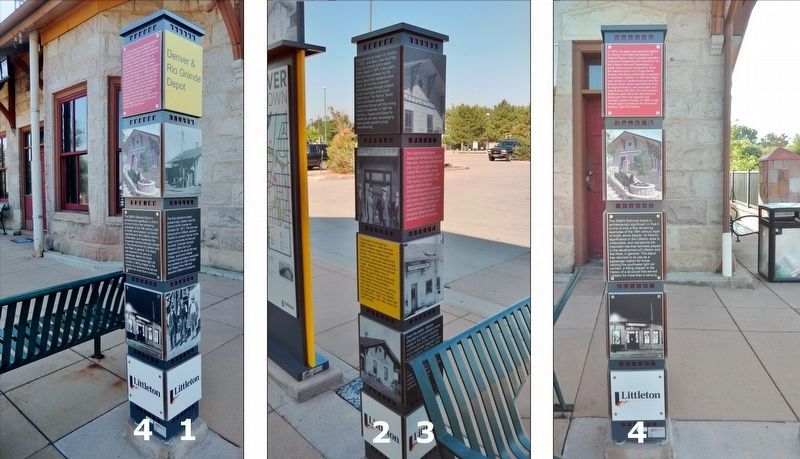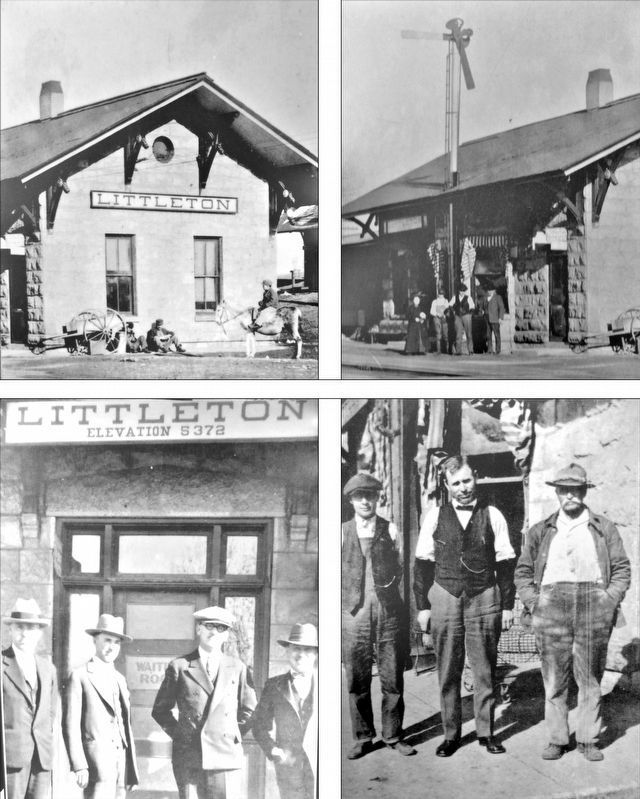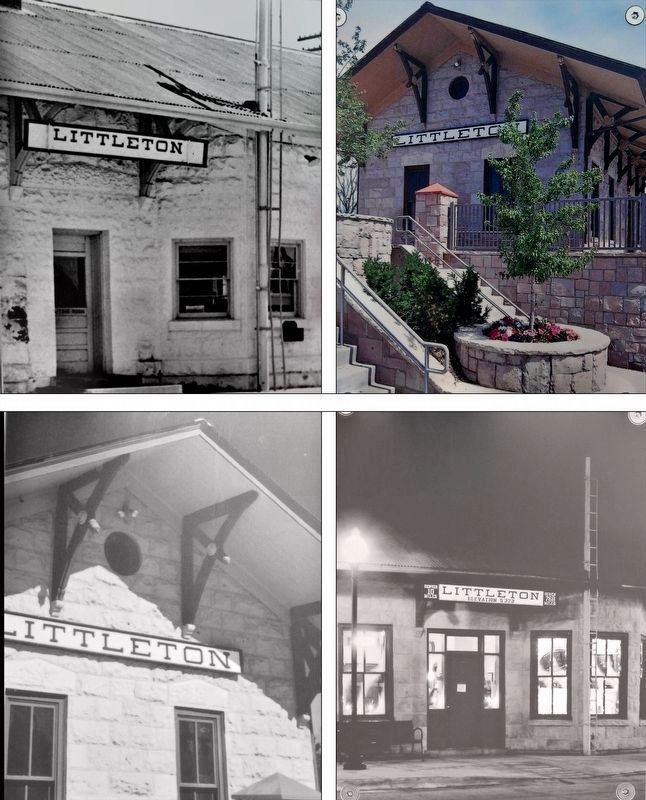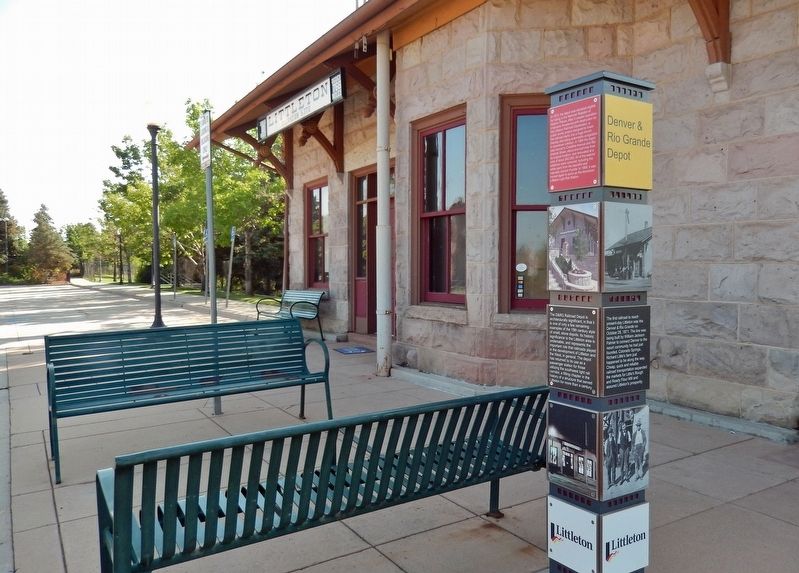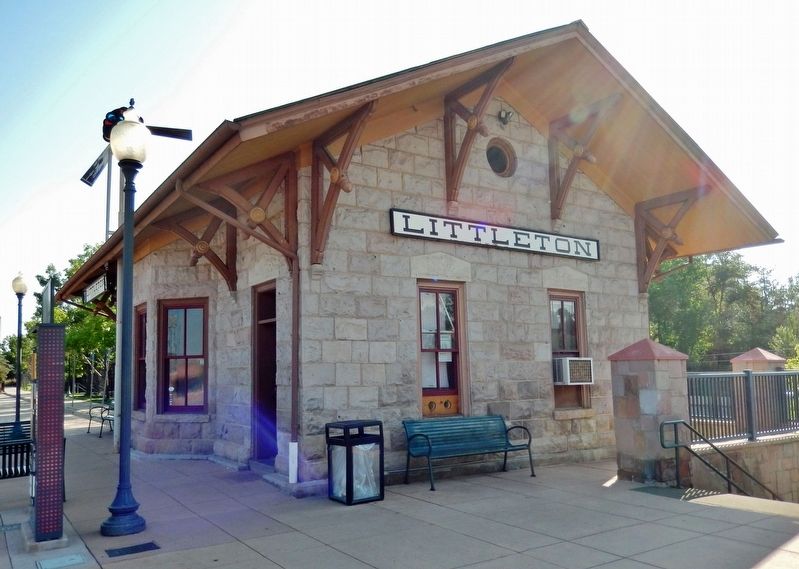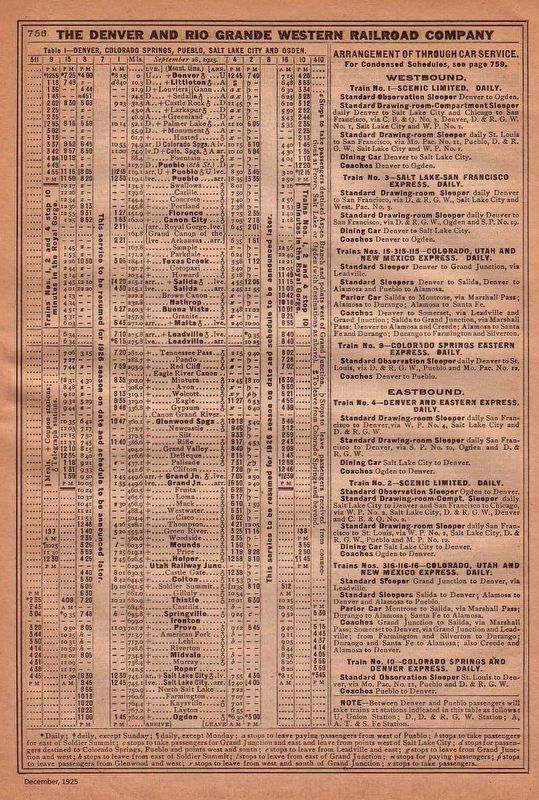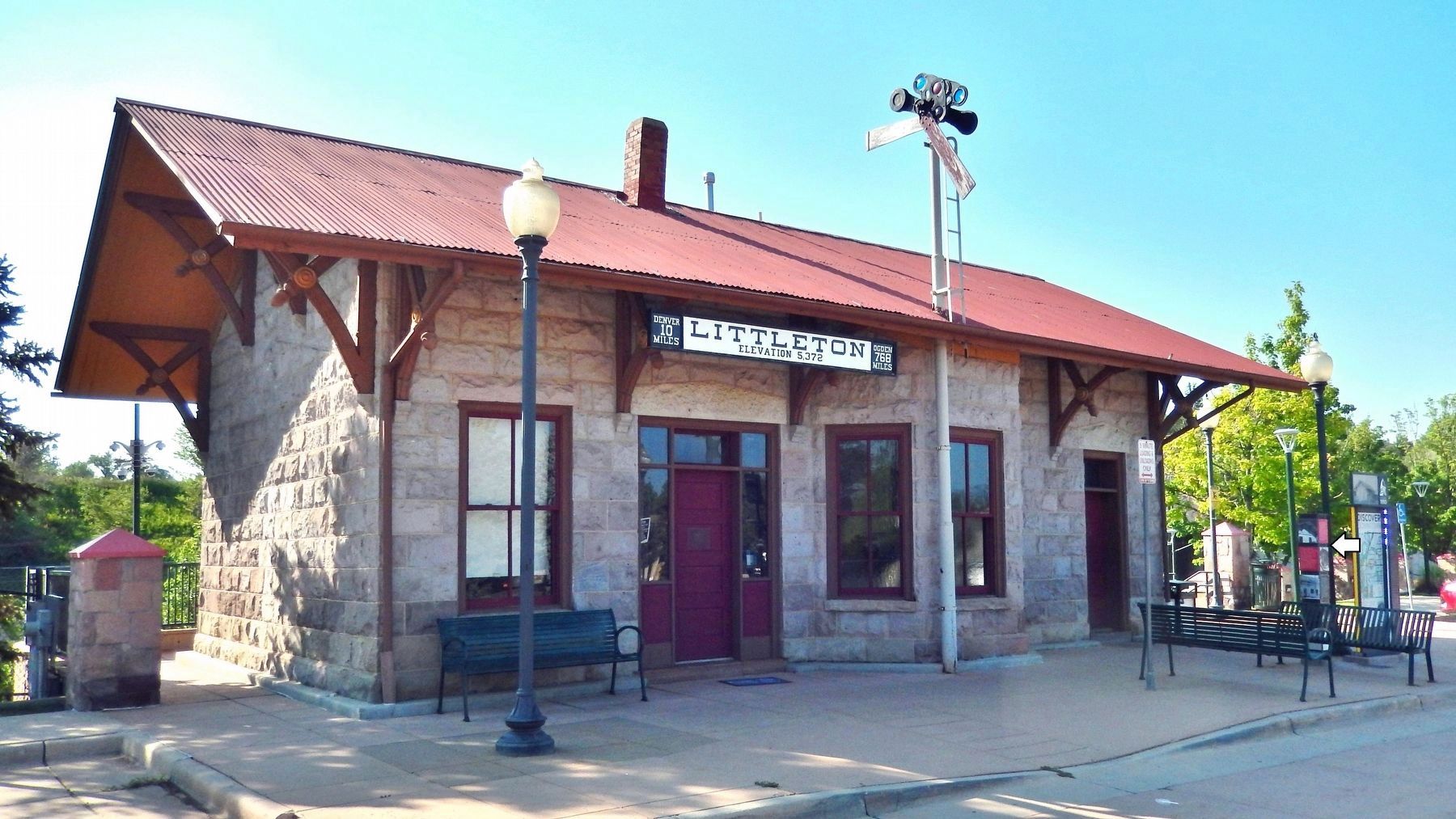Littleton in Arapahoe County, Colorado — The American Mountains (Southwest)
Denver & Rio Grande Depot
Inscription.
The first railroad to reach present-day Littleton was the Denver & Rio Grande on October 28, 1871. The line was being built by William Jackson Palmer to connect Denver to the resort community he had just founded, Colorado Springs. Richard Little's farm just happened to be along the way. Cheap, quick and reliable railroad transportation expanded the markets for Little's Rough and Ready Flour Mill and assured Littleton's prosperity.
Regular service began on January 1, 1872, and after a year as a flag stop, the railroad built a wood-frame depot in 1873. A few years later this was replaced by the stone depot that residents know today. By this time a second railroad passed through Littleton on the west side of the South Platte River. The Denver, South Park and Pacific railroad connected Denver with the mining district of Leadville. In 1887 the Atchison, Topeka and Santa Fe added its own rails, encouraging even greater growth in local manufacturing.
The heyday of railroading in Littleton began in 1889 when the D&RG initiated regular commuter service between Littleton and Denver. The train was dubbed the Uncle Sam, because it also served the newly opened army post at Fort Logan. Running up to six trips per day, it turned Littleton from a relatively quiet farming community into a bedroom suburb of Denver. New modes of transportation reduced the reliance on rail service soon after the turn of the century, and passenger service to Littleton discontinued in 1967. The depot still handled freight until 1982, when the depot closed.
The original stone depot measured 48 feet long and 24 feet wide, and was constructed with rough cut (quarry cut) Castle Rock rhyolite, a very popular building stone in late 19th century Colorado. The gabled roof has deep overhanging eaves supported by timber brackets decorated with acorn shaped finials. On each of the gabled ends is a round window, which was probably added more for aesthetics than for function.
Over the years, various alterations and additions were made to the depot including: construction of bay windows and a separate baggage room to the north in 1906; the 1942 enclosure of the area between the buildings and addition of a two-lavatory lean-to on the east side; white and green exterior paint, interior remodels and changes to many of the windows and doors.
In 1973, the depot was declared eligible for listing in the National Register of Historic Places. After it ceased operation, it became threatened with destruction by the Littleton Railroad Depression, a public works project designed to lower the railroad tracks into a huge trench, thereby alleviating automobile congestion in downtown Littleton. In 1984 the depot was moved to Crestline Avenue and Rio Grande Street, about one-half mile from its original location, and renovated at a cost of about $40,000. All of the exterior additions were removed, including the white paint from the beautiful and naturally colored rhyolite. In 1999, it was moved again to serve as the downtown Littleton Light Rail Station.
The D&RG Railroad Depot is architecturally significant, in that it is one of only a few remaining examples of the 19th century style of small, stone depots. Its historic significance to the Littleton area is undeniable, and represents the important role that railroads played in the development of Littleton and the West, in general. The depot has returned to its use as a passenger station for those utilizing the southwest light rail corridor, a fitting chapter in the history of a structure that served Littleton for more than a century.
Topics. This historical marker is listed in these topic lists: Architecture • Industry & Commerce • Railroads & Streetcars • Settlements & Settlers. A significant historical date for this entry is October 28, 1871.
Location. 39° 36.713′ N, 105° 0.919′ W. Marker is in Littleton, Colorado, in Arapahoe County. Marker can be reached from South Prince Street south of West Alamo Avenue, on the left when traveling south. Marker is located near the southwest corner of the old Littleton Railroad Depot, now known as the Downtown Littleton Light Rail Station. Touch for map. Marker is at or near this postal address: 5777 South Prince Street, Littleton CO 80120, United States of America. Touch for directions.
Other nearby markers. At least 8 other markers are within walking distance of this marker. Public Transportation (within shouting distance of this marker); Rough and Ready (within shouting distance of this marker); The Good, The Bad, and the Hungry (within shouting distance of this marker); Littleton, Colorado Post Office (about 500 feet away, measured in a direct line); Arapahoe County Courthouse (approx. 0.2 miles away); J. D. Hill General Store (approx. ¼ mile away); Weston Masonic Lodge (approx. ¼ mile away); A Memorial to the Pioneers (approx. 0.3 miles away). Touch for a list and map of all markers in Littleton.
Also see . . .
1. Denver & Rio Grande Railroad Depot. Littletown website entry:
The main entrance is a large paneled door with two paneled and glass sidelights with a transom window above the door. Most of the windows are double hung with divided lights (muntins). Some of the windows have stone pediment lintels. The second entrance is a paneled door with a stone
pediment lintel. Next to the Littleton sign is the original signal tower. (Submitted on July 18, 2021, by Cosmos Mariner of Cape Canaveral, Florida.)
2. Littleton Denver & Rio Grande Western Depot. Library of Congress exterior and interior photo gallery. (Submitted on July 18, 2021, by Cosmos Mariner of Cape Canaveral, Florida.)
Additional commentary.
1. Passenger Trains in 1925
The Littleton depot was on The Denver and Rio Grande Western Railroad main line between Denver, Colorado Springs, Pueblo, Salt Lake City and Ogden. Denver Union Station was 27 minutes east, according to timetables in in the Official Guide of the Railways for December 1925. Rail miles on this line were measured from Denver, so this depot, at mile marker 10.3, was a little over 10 very slow miles from Denver. The timetable shows 83 passenger stations between Denver and Ogden.
Colorado Springs was at mile marker 74.9 and 2 hours and 19 minutes away on the local train that stopped at every station in between, or 2 hours and 3 minutes away on an express train that rushed through many of the stations without stopping. Pueblo was at mile marker 117.7 or 3:26 away, Salt Lake City was at mile marker 745.1 and a little under 27 hours away, and Ogden at mile marker 782 and just over 29 hours away because of a 15 minute stop in Salt Lake City. If you do the math you’ll see that these trains averaged only 26 miles per hour on their journey up and down the Rocky Mountains.
Express trains that ran through “the Grand Canyon of the Royal Gorge” during the day stopped there for 10 minutes so that passengers could take in the scenery. They were trains No. 1 and 2, the daily westbound and eastbound Scenic Limited, and train No. 4, the daily eastbound Denver and Eastern Express. The Royal Gorge stop was five and a half hours west from Littleton.
In total, ten passenger trains a day in the summer—eight in the winter—passed through this depot, five in each direction. In addition to the pair of Scenic Limiteds and the Denver and Eastern Express, there were Salt Lake-San Francisco Express with through sleeping cars between Chicago and San Francisco, and the Colorado, Utah and New Mexico Express to and from Denver, Alamosa and Santa Fe via Grand Junction. Finally, there was the eastbound Colorado Springs and Eastern express with cars destined for St. Louis. All D&RGW express trains included sleeping
accommodations and dining and observation cars.
These passenger trains kept the station staff busy on and off all day, stopping for a minute or less to board and discharge passengers and their luggage as well as express freight, and mail, with the first daily train at 6:48 AM and the last at 7:49 PM.
— Submitted December 30, 2023, by J. J. Prats of Powell, Ohio.
Credits. This page was last revised on December 30, 2023. It was originally submitted on July 18, 2021, by Cosmos Mariner of Cape Canaveral, Florida. This page has been viewed 414 times since then and 67 times this year. Photos: 1, 2, 3, 4, 5. submitted on July 18, 2021, by Cosmos Mariner of Cape Canaveral, Florida. 6. submitted on December 30, 2023, by J. J. Prats of Powell, Ohio. 7. submitted on July 18, 2021, by Cosmos Mariner of Cape Canaveral, Florida.
